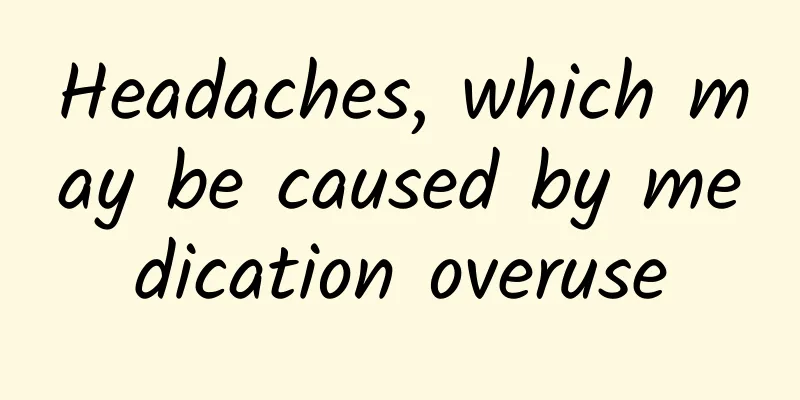Headaches, which may be caused by medication overuse

|
Author: Zhao Jialing Sichuan Academy of Medical Sciences (Sichuan Provincial People's Hospital) Reviewer: Fan Dongsheng, Chief Physician, Peking University Third Hospital There is a type of patient who suffers from headaches almost every day. They take certain analgesics on their own for a long time, but the headaches can only be relieved temporarily. The headaches are persistent and seriously affect the patient's physical and mental health and the quality of life and work. When encountering such patients, we should be highly vigilant about medication overuse headache (MOH). Figure 1 Copyright image, no permission to reprint 1. What is MOH? MOH refers to the frequent attacks of headaches that occur after headache patients regularly and excessively use analgesics. As the drugs are withdrawn, the headache will gradually ease or return to the previous headache state. It is also called "rebound headache", "drug-induced headache" and "drug misuse headache". Figure 2 Copyright image, no permission to reprint The International Classification of Headaches (3rd Edition) (ICHD-3) points out that there are seven main categories of common drugs that cause MOH: ① ergotamine; ② triptans; ③ simple analgesics (usually non-steroidal anti-inflammatory drugs, such as acetaminophen and aspirin); ④ opioids; ⑤ combination analgesics; ⑥ combination medication a (but each single drug is not excessive) or combination medication b (specific details are unknown); ⑦ other drugs. At present, the common drugs that cause MOH in China are mainly caffeine-containing compound preparations, including pain-killing tablets, compound aspirin, phenol coffee tablets, brain-clearing tablets and certain traditional Chinese medicines (such as Acanthopanax, Shuanghuanglian and Astragalus, etc.); there are also a few patients who overdose on ibuprofen, acetaminophen, tramadol and ergotamine. In foreign countries, triptan drugs, single or compound analgesics are more common. The development of MOH usually begins with episodic headaches, usually in patients with a history of migraine or tension headaches that have been treated with frequent and excessive use of acute analgesics. In clinical practice, MOH usually presents as a headache that is present or develops upon awakening. The severity, location, and type of MOH can vary greatly between individuals, but headaches usually occur daily or nearly daily. The condition can be accompanied by symptoms such as nausea, weakness, difficulty concentrating, memory loss, and irritability. Figure 3 Copyright image, no permission to reprint Figure 4 Copyright image, no permission to reprint 2. MOH’s Self-Judgment If you want to know whether you have MOH, you can make a preliminary judgment based on the following three criteria. 1) The patient had suffered from primary headaches (mainly migraine and tension headaches) before and currently has headache symptoms for at least 15 days per month. 2) Regularly taking one or more symptomatic analgesic drugs for ≥10 days or ≥15 days per month (depending on the type of drug used, such as ergotamine, opioids, combined analgesics, etc., taken ≥10 days per month, simple analgesics such as acetaminophen, aspirin or other non-steroidal anti-inflammatory drugs, etc., taken ≥15 days per month), and taking them continuously for more than 3 months. 3) The headache is not better explained by another disorder. 3. Treatment of MOH 1) People with headaches should be aware of the harmful effects of overuse of analgesics. They need to understand that analgesics may cause MOH and that overuse of analgesics may negate or reduce the effectiveness of headache prevention measures. 2) Withdraw overused acute symptomatic medications. Stopping overused medications can reduce the frequency of migraine attacks by 51%. 3) Add preventive drugs [mainly beta-blockers, some anti-epileptic drugs (such as valproic acid, topiramate, etc.), calcium channel blockers (such as flunarizine, etc.) and antidepressants (such as amitriptyline, etc.)]. 4) Treatment of withdrawal symptoms, etc. (such as symptomatic antiemetics). 5) Behavioral therapy (as needed). 6) Long-term treatment of primary headaches. |
<<: Seven questions and answers about osteoporosis, for healthy bones
>>: Comprehensive care for pediatric diarrhea: from diet to intestinal health
Recommend
Revealed! Ten benefits of men's sperm to women
Everyone knows that semen is good for both men an...
What should girls do when they have their periods?
Women should keep warm during menstruation. Women...
Can I take penicillin while breastfeeding?
Everyone must be familiar with penicillin. It is ...
What brand is Suzy's lipstick from Rogue? The same lipstick color and color test
In the drama "Vagabond", Suzy took out ...
What tests should be done after miscarriage?
Although the technology of abortion surgery is ve...
What causes vaginal bleeding in women?
What causes vaginal bleeding in women? This is a ...
What is the climate like in Weihai? Characteristics of Weihai
Cities by the sea generally have a relatively hum...
How do the elderly choose vaccines that are suitable for them? Experts from World Immunization Week come to popularize science
How do the elderly choose vaccines that are suita...
What is a lunar rover? What is the temperature inside the moon?
The moon, commonly known as the moon, is also cal...
Nipple discharge is clear watery
If the liquid overflowing from the nipple appears...
Four-dimensional color ultrasound of 6-month-old chicks
Nowadays, more and more pregnant women are doing ...
[Panxiong Science] Small lung nodules enter individualized diagnosis and treatment. Should an 8 mm nodule be treated with surgery or observation? How to achieve a successful surgery?
As the public pays more attention to health, more...
Explore the mystery of "human parapneumovirus" and protect respiratory health
Winter is the peak season for respiratory disease...
How to treat sudden inverted nipples?
A woman’s breast health is related to all aspects...









